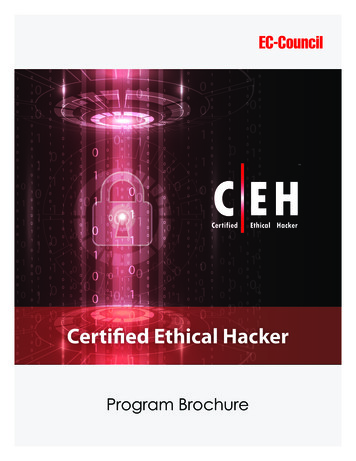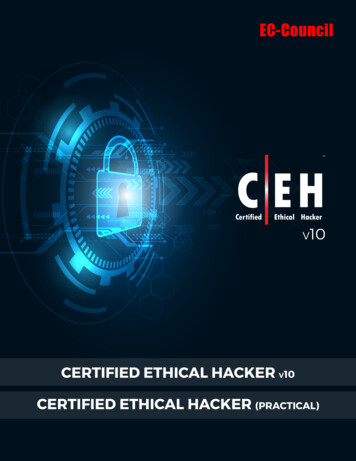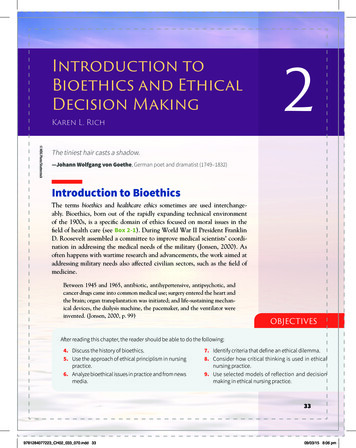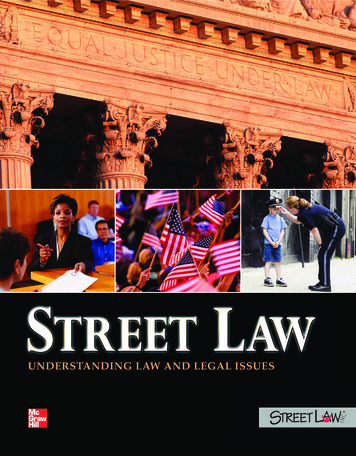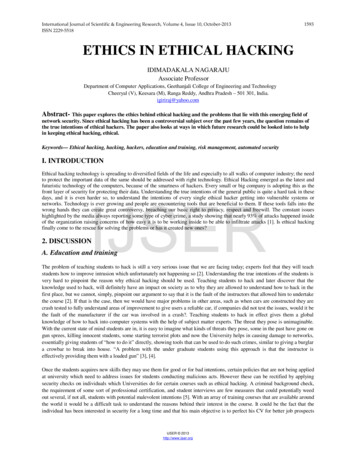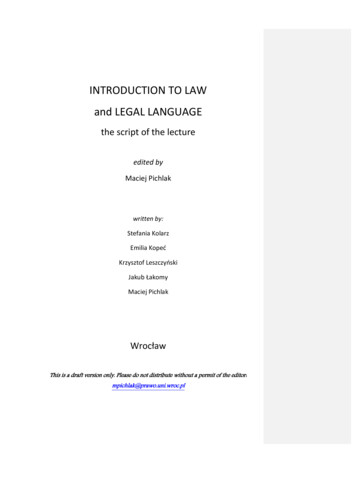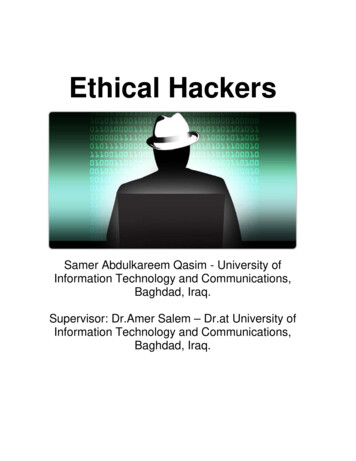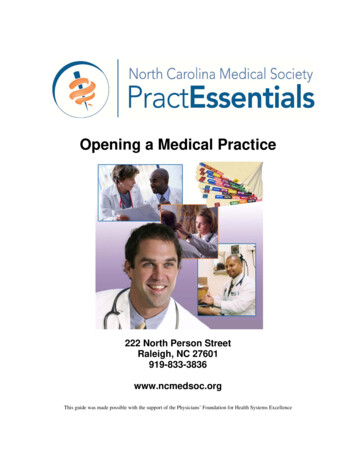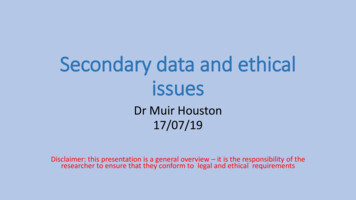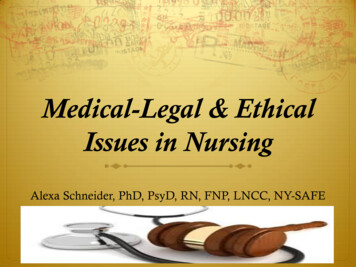
Transcription
Medical-Legal & EthicalIssues in NursingAlexa Schneider, PhD, PsyD, RN, FNP, LNCC, NY-SAFE
Objectives Describe how current and future healthcare trends will impactlegal and ethical issues in nursing, patient care technicians,social workers, and office personal. Describe “best practices” that protect your license andposition, influence quality of care and reduce risk. Examine medical malpractice cases and the impact on thenurse and the various roles in the acute, long term care &outpatient setting.
Current and future healthcaretrends Role of nurse continues to expand & is influenced bymany aspects.
Trends
Best Practicesthat protect your license, influence quality of care and reduce risk.School:Learn to obtain licenseAfter school:Learn to maintain/protect/keep license
Medications Giving meds on time – not when convenient for nurse(Heparin, Antibiotics, and etc.) Giving med andscanning med at a later time. Proper wasting of narcotics 5 rights No over riding system unless absolutely necessary. Don’t cover up if medication error occurs.
DNR Know your patients DNR status Legal order signed by the Doctor View original paperwork
Patient confidentiality Never leave paper chart/computer screen in a public place Discuss contents only with persons directly involved inpatient’s care or those authorized by the patient. They shouldbe listed by name. (Don’t assume partners have access toinformation) Ask for ID prior to providing information Do not discuss pt or pts info in public, places, elevators,cafeteria, or at parties. Don’t view patient’s information not in your care: family;friends; celebrities and etc.
Patient Falls & Restraints Among senior citizens, falls represent the 5th leadingcause of death, and the mortality rate from fallsincreases significantly with age. Cases Failure to follow policy Failure to raise bedrails
Criteria for Incident Reports Should be completed for any usual, unexpected, orunanticipated occurrences, and for any event which hasor may have an adverse patient outcome. Patient falls Medication error Loss of valuables, belongings Equipment malfunction Property damage Near misses
Incident reportsBe Objective Do not blame or admit liability What did you do? Do not include names/addresses of witnesses Document time/name of medical provider Do not file in chart Do not write “incident report made”
Proper handoffcommunication Required to properly “handoff ” your patients to anotherqualified professional. Tool SBAR: S Situation: patient name, DOB, & medical provider B background: date of admission, diagnosis & currentcondition including test results A Assessment: summary of recent events/changes incondition or treatment and any anticipated changes in conditionor treatment. R Recommendations: state your nursing recommendationswith any new treatment in the plan of care by the medicalprovider.
Abandonment Termination of patient care without assuring thecontinuation of care at the same or higher level. In various medical venues (office/clinic practice; walking offthe job; leaving pt without transferring pt to another nurse;refusing overtime) (6)
Sexual Misconduct
Controlled Substances Self-prescribing controlled medication for one’s own useor for family members. Diversion
Social Media Facebook Twitter Texts E-mailsInfo about & from patients
Telephone calls Office scenario Date and time of call Advice you gave Who you spoke with and if other caregivers notifiedHospital scenarioDate and time of callProvider nameClient’s chief complaintInformation you providedOrders received/not received Nurses who disagree with a provider’s order should not carry out anobviously erroneous error.
Pitfalls for Staff
Red Flag Complaints
Documentation
Documentation Written evidence of interaction between and among health professionals,patients, and their families; the administration of procedures, treatments, anddiagnostic tests; the patient’s response to them and education of the familysupport unit. Major purpose of medical record is to document the care given to the patient. Nurse Practice Act states the general duty is to “record pertinent informationincluding the response to interventions”. Also a legal document. Courts have issued a warning to nurses & medicalpersonnel that the availability of accurate medical records is NOT a technicalitybut IS a legal requirement. Chart is a persuasive witness because it’s a description of the facts at the time. Should be no unanswered questions to the patients chart that the plaintiffattorneys can use to construct their version of what happened. Documentation reflects: character, competency, and the care delivered by thenurse
Documentation Do’s Nursing procedures (procedure name; when performed; whoperformed; how performed; client tolerated; adverse reactions) Phone calls Health care team visits Don’t wait to chart Client refusals Client’s subjective data Medication omission Late entry Not applicable
Required to document Sudden decline in patient’s condition, actions, outcome Patient injuries/medication errors Equipment failure/incorrect use Failure of provider to respond The “red flag” patient or family Client/family education/instructions
Documentation Don’ts Complaints Opinions Altering the record Chart ahead Staffing problems Staff conflicts Leave empty lines/spaces Make reference to incident reports
Documentation The following can lead to state licensing boardsuspending or revoking nurse license: Failure to document entries in patient record Falsification of patient record Making incorrect entries Each health care provider is responsible for the ABC’s ofrecording: Accuracy, brief, complete
Documentation The old adage, “If it wasn’t charted it wasn’t done .” isclarified in CBE (charting by exception) as “If interventions,expected outcomes, and patient responses weren't chartedusing symbols to reflect predefined norms-and variancesweren't charted in detail-then it wasn’t done.” CBE is a shorthand of documenting normal findings, basedon clearly defined normal, standards of practice, andpredetermined criteria for assessments and interventions.Significant findings or exceptions to the predefined norms aredocumented in detail. Computerized charting: Protect password security & don’tforget to log off
Common Charting mistakes Failing to record pertinent health or drug info Failing to record nursing actions Failing to record that medications have been given Recording on the wrong chart Failing to document a discontinued medication Failing to record drug reactions or changes in the patient’scondition Transcribing orders improperly Writing illegible or incomplete records
Effective Documentation Wrong: Communication with patient’s family begantoday to specify the manner in which his condition isprogressing and suggest a probable consequence of thatprogression. Correct: I contacted Mr. Schneider’s wife at 1332 hours.I explained that his cardiac status was worsening andthat he was being prepared for a cardiac cath procedurescheduled for 1430.
Late entries Add late entries at first available space and as soon aspossible if electronic Document date and time the event occurred Clearly identify the entry as a late one
Red Flags Adding information Dating the entry Dates/times conflict Inaccurate information Destroying records
Documentation Cases usually come to court a long time after the eventsoccurred Nurses and other personnel usually have little or norecollection of the events surrounding the case and must relyon their documentation for what occurred. Do you feel like your documentation would support you in acourt of law?
Implications
2015 Statistics
MEDICAL MALPRACTICE Malpractice occurs when improper, injurious, or faultytreatment of a client that results in illness or injury.Why Claims are Filed Upset with the System Devastating Injuries Unreasonable Expectations Unexpected Results
Extent of Suits
Sued the most
Legal Role of the Nurse Provider of service Ensure that client receives competent, safe, & holistic care Render care by “standards of reasonable, prudent person” Supervise/evaluate that which has been delegated Documentation of care Maintain clinical competency
Legal Negligence in Nursing Failure to use equipment in a responsible manner Failure to assess and monitor and failure tocommunicate Failure to document Failure to act as a patient advocate Performing nursing procedures incorrectly Failing to take appropriate precautions
Responsible &Accountable You are responsible and accountable for your actionsbased on: Your clinical training Your title Scope of practice Standard of care guidelines Policies and procedures of your health care facility
Ways to AvoidMalpractice Know your own strengths and weaknesses Evaluate your assignment Delegate carefully Exercise caution when assisting procedures Document the use of restraints Take steps to prevent falls Comply with laws about advance directives Follow hospital policies and procedures Keep policies and procedures up to date Provide a safe environment
ELEMENTS OF NEGLIGENCE Deviation from the standard of care that results in harm to the patient 4 elements of negligence Duty to act (Nurse – Patient relationship) Breach of duty (SOC not followed - reasonably prudent nurse) Damage (Physical & Psychological) No damage no case! Causal connection (reasonably close connection between nursesconduct & injury)All 4 must be proven
State Boards of Nursing NYSBON was created to “assist the Board of Regents andother departments on matters of professional licensing,disciplinary process and practice of the professions.” Ensure public safety from dishonest and incompetentpractitioners Ensure that you practice within your scope of practices,SOC guidelines, and other state statues. Ensure that you are not impaired physically or mentallyfrom drugs and alcohol while practicing. Ensure that nursing schools provide you with adequateeducation and clinical skills needed to provide quality care.
Nursing Charges Most common charges brought against nurses include Substance abuseIncompetenceNegligenceState board of nursing is responsible for discipline within the profession.The Board participates in licensure, disciplinary, restoration, and moralcharacter proceedings.All members of the State Board and the committee for professionalassistance must be dedicated to the public protection, qualityprofessional preparation, and conduct.
THREE CATEGORIES OFIMPAIRMENT PROFESSIONAL BEHAVIORAL Deficit in Medical Knowledge, Expertise or JudgmentIncludes unprofessional, unethical, or criminal conductMEDICAL Conditions which permanently impede or preclude a providerfrom safely practicing medicine
Professional Misconduct Violating any guidelines set forth by your state nursing boardplaces you at risk of being charged with professionalmisconduct. Obtaining license fraudulently Practicing while impaired by ETOH, drugs, physical or mentaldisability. Habitual drunk or dependent on narcotics and other drugs withsimilar affects Refusing to provide professional service to a person based onrace, creed, color, or national origin Practicing beyond authorized scope, with gross incompetence,with gross negligence on a particular occasion or negligence orincompetence on more than one occasion.
Maintaining License & aValid Registration Certificate Professional license is “valid for life unless revoked orsurrendered for professional misconduct.” It’s your obligation & responsibility to be mindful of thefollowing when it comes to maintaining your registration: Expiration date. If expired do not practice until renewed. Report name or address change to licensing agency for futurerenewals. Answer all questions pertaining to both criminal convictions& terminations of employment truthfully. Practice within your scope of practice and standard of careguidelines.
Code of Ethics Code of ethics defines the moral principles that govern howyou practice nursing and is the foundation on which nursing isbuilt. Legal definition: “the minimum standards of appropriateconduct within legal and regulatory parameters involving theduty owed to your patient and other members of yourprofession.” Submitting work vouchers for home care visits not madeBreach of confidentialityFraudRefusing to provide care for patient of specific cultural origin
Grounds for Suspension &Revocation of License Incompetent nursing practice Professional misconduct Conviction of a crime (Homicide; theft; manslaughter; illegible possession of controlled substance; sexualassault; arson; DUI)Violations may include Procurement of a license by fraud Unprofessional, dishonorable, immoral, or illegal conduct Performance of specific actions prohibited by statue MalpracticeHearings: Moral Character; Disciplinary; RestorationActions taken are based upon the severity of the violation. (reprimand or warning; probation;suspension of license; revocation of license)
Be Competent in YourPractice You are always held accountable for their own behavior. Refusal to perform procedure for which they have notbeen prepared. Be reminded that the Nurse Practice Act changes ever sooften; it is the responsibility of all nurses to be currentwith the laws that govern their scope of practice. “Ignorance of the law is no excuse.”
Impaired Referred to PAP (professional assistance panel) if noharm to patient Surrender license while receiving treatment Participate in PAP program (SPAN) If successfully complete the NYS PAP programdisciplinary charges will not be brought up against youfrom the bureau of controlled substance or StateEducation Dept.
Cases
Conclusion Embrace and participate in current and future trends. Maintain “best practices” that protect your license,influence quality of care and reduce risk. Make the most of every day & have a grateful heart.
legal and ethical issues in nursing, patient care technicians, social workers, and office personal. Describe “best practices” that protect your license and position, influence quality of care and reduce risk. Examine medical malpractice cases and the impact on the nurse and the various

